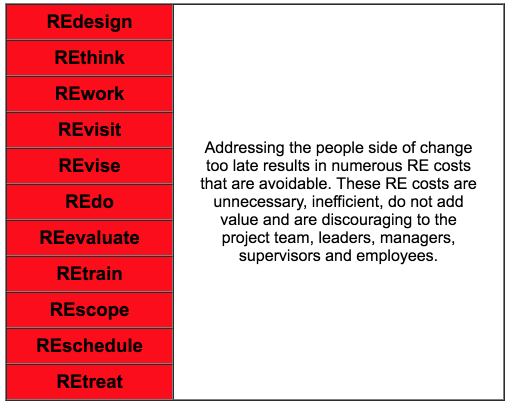Avoid the RE Costs of Poorly Managed Change

3 Mins
Updated: August 5, 2024
Published: November 17, 2021

Today, organizations face tremendous pressure to change more often, more quickly, and at a larger scale than ever before—and can no longer tolerate inefficiencies in the change process. Yet, each time a project launches and moves through design, development and implementation without applying change management, inefficiencies emerge. These "RE" costs result when people don't adopt and use the project solution. Fortunately, addressing the people side of change early in a project's life cycle helps you avoid or eliminate many of these costs.
Individuals Are the
Building Blocks of Successful Change
Projects and initiatives create change in a variety of ways by introducing some sort of solution to the organization. These solutions often emerge in the form of new or altered processes, new systems or tools, new reporting structures, new job roles, or new ways of operating. There is often a great deal of focus on designing the "right" solution to the change. The goal of the solution is to improve performance in the organization and to achieve the desired results and outcomes that triggered the change in the first place.
In the end, though, these solutions each require individuals to change how they work. A newly designed and documented process delivers improved efficiency only when individuals follow the process. A newly developed technology or tool comes to life only when it is used by individuals in the organization. Conversely, a perfectly designed process that no one adheres to does not deliver the intended results and outcomes. A perfectly designed tool that no one uses results in no improvement (and a hefty, negative ROI). Change does not result from a solution. Change results from employees exhibiting the new behaviors, adhering to the new processes, following the new workflows, or using the new tools the solution triggered.
The individual is the unit of change, and individuals are the building blocks of successful change within an organization. When we address the people side of a change early in the project lifecycle, we can influence and guide important decisions about adoption and usage, and help the people impacted by the change move through their individual transitions. But if we address the end user too late, RE costs result.
Avoidable "RE" Costs of Change
Think about your experience working on projects and initiatives. Have you experienced one or more of the common RE costs below? Could you have avoided them by addressing the people side of change earlier in the project lifecycle?

Repeating any activity adds costs in the form of wasted time, financial resources and lost opportunity. Schedules and budgets must be expanded. We miss potential revenue during the time it takes to REdo and REwork because project team members are tied to the project longer than expected and unable to take on a new project. And we achieve the project's anticipated benefits later, along with a delayed return on investment (ROI).
We can avoid many RE costs, and the reason is simple: change happens one person at a time. The people side of change is the bridge between installing a solution and realizing the solution's benefits. It's the critical ingredient that ensures that a great solution delivers the intended results and outcomes. When the people side of change becomes part of the strategy early in a project, organizations can manage individual change processes collectively and correctly the first time and achieve the project's business results without RE costs.

Start Change Management Early
Prosci's Best Practices in Change Management research shows that change management should be applied as early as possible in the project life cycle. In the most recent study, 47% of participants who started change management at project initiation met or exceeded objectives, while only 29% of those who started at closure did. When asked when they would start change management activities next time, 97% of respondents said during the project initiation or project planning stages.
Advantages of applying change management early in the project lifecycle include:
- Being more proactive
- Sequencing people side activities with project activities
- Delivering the right information in a timely manner
- Mitigating resistance before it has an impact
- Ensuring adequate sponsorship
- Providing input to solution design decisions
Addressing the people side of change late in the project lifecycle is costly and inefficient, which undermines project success and ROI. When change management is applied late in the project lifecycle, we typically focus on "fighting fires" and damage control, and the available change management activities are limited. Without early attention to the people side of change, the project creates more resistance, confusion, stress and fear with employees in the organization, and change fatigue sets in.

Change Management and Efficiency
We know that organizational change is the collective result of individual change. Without change management, project plans, budgets and schedules often go off course due to the people-side problems that inevitably arise. For organizations that place a high value on efficiency, avoiding the RE costs is an effective rationale for applying change management early in a project lifecycle and building support for it among leaders.


